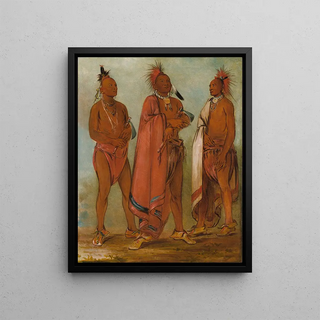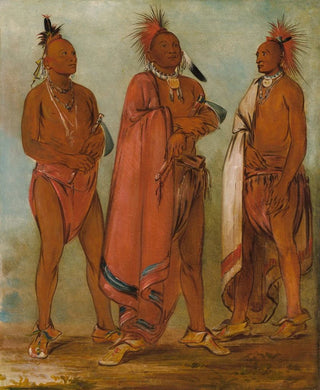Art print | WaMshEeSheek The one who removes WaChshUk War MinkChsk Three distinguished young men - George Catlin


View from behind

Frame (optional)
The artwork "WaMshEeSheek The one who takes away WaChshUk War MinkChsk" by George Catlin stands as a vibrant testament to Native American culture through the lens of a passionate artist. Catlin, as a painter and explorer, masterfully captured not only the physical appearance of his subjects but also the very essence of their identity and way of life. This art print, echoing the original, allows viewers to immerse themselves in a universe where every detail is imbued with meaning and history. It evokes a bygone era while prompting reflection on our relationship with memory and representation.
Style and uniqueness of the work
Catlin's style is characterized by meticulous attention to detail and a vibrant color palette that brings his portraits to life. In "WaMshEeSheek The one who takes away WaChshUk War MinkChsk," the figures are rendered with precision that highlights their individuality. Traditional costumes, adorned with motifs and symbols, testify to ancestral craftsmanship and a deep connection to the land. Each character seems to tell a story, and the artist manages to establish a dialogue between the viewer and the subjects depicted. The composition of the work, both dynamic and balanced, invites attentive contemplation, where each gaze reveals a new aspect of Native American culture.
The artist and his influence
George Catlin, born in 1796, is often regarded as one of the first artists to document North American indigenous peoples. His work transcends mere artistic representation to become an act of cultural preservation. At a time when Native populations faced radical changes, Catlin chose to immortalize them on canvas, providing visibility and recognition that were often denied them. His influence extends beyond his era, inspiring many artists and anthropologists to explore indigenous cultures. Through his work, Catlin contributed to a better understanding of the social and cultural dynamics of these peoples, making their heritage accessible.

Matte finish

View from behind

Frame (optional)
The artwork "WaMshEeSheek The one who takes away WaChshUk War MinkChsk" by George Catlin stands as a vibrant testament to Native American culture through the lens of a passionate artist. Catlin, as a painter and explorer, masterfully captured not only the physical appearance of his subjects but also the very essence of their identity and way of life. This art print, echoing the original, allows viewers to immerse themselves in a universe where every detail is imbued with meaning and history. It evokes a bygone era while prompting reflection on our relationship with memory and representation.
Style and uniqueness of the work
Catlin's style is characterized by meticulous attention to detail and a vibrant color palette that brings his portraits to life. In "WaMshEeSheek The one who takes away WaChshUk War MinkChsk," the figures are rendered with precision that highlights their individuality. Traditional costumes, adorned with motifs and symbols, testify to ancestral craftsmanship and a deep connection to the land. Each character seems to tell a story, and the artist manages to establish a dialogue between the viewer and the subjects depicted. The composition of the work, both dynamic and balanced, invites attentive contemplation, where each gaze reveals a new aspect of Native American culture.
The artist and his influence
George Catlin, born in 1796, is often regarded as one of the first artists to document North American indigenous peoples. His work transcends mere artistic representation to become an act of cultural preservation. At a time when Native populations faced radical changes, Catlin chose to immortalize them on canvas, providing visibility and recognition that were often denied them. His influence extends beyond his era, inspiring many artists and anthropologists to explore indigenous cultures. Through his work, Catlin contributed to a better understanding of the social and cultural dynamics of these peoples, making their heritage accessible.






